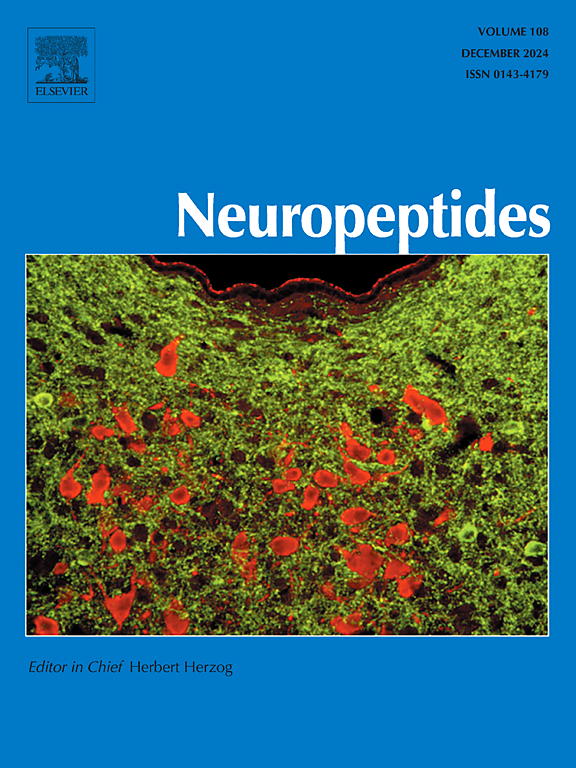运动或外周注射造成的与生理相关的乳酸积累不会改变小鼠的中枢或外周食欲信号传导
IF 2.7
3区 医学
Q3 ENDOCRINOLOGY & METABOLISM
引用次数: 0
摘要
乳酸盐与运动引起的食欲抑制有关,但很少有研究探讨其作用机制。最近的研究表明,通过运动和脑室内注射进行乳酸盐蓄积可改变中枢食欲调节途径,但乳酸盐是超生理剂量的,而且没有对外周食欲标记物进行评估。因此,我们研究了通过运动或腹腔注射造成的生理学相关乳酸累积如何改变中枢和外周食欲信号通路,以及乳酸脱氢酶抑制剂草酸盐是否能减弱任何运动效应。40只10周大的C57BL/6 J雄性小鼠(n = 10/组)被分配到以下任一组:1)静坐(SED + SAL;生理盐水);2)运动(EX+SAL;生理盐水);3)含草酸盐的运动(EX+OX;750 mg‧kg-1体重);或4)乳酸盐(SED + LAC;1.0 g‧kg-1体重)。运动/注射后 2 小时采集血液、胃和下丘脑样本。虽然与 EX+SAL 条件相比,草氨酸盐能减弱运动诱导的乳酸累积(P = 0.044,d = 0.73),但不同组间的循环酰化胃泌素或胃泌素 O-酰基转移酶含量没有差异(P > 0.213,ηp2<0.125)。下丘脑中的神经肽 Y、前黑皮素、激动相关肽和α-黑素细胞刺激素含量也没有差异(P> 0.150, ηp2<0.170)。与 EX+OX 相比,运动确实增加了磷酸化-信号转导子和转录激活子 3(pSTAT3)的总量(P = 0.065,d = 1.23),但乳酸信号转导的其他标记物:磷酸化-单磷酸腺苷激活的蛋白激酶总量和蛋白激酶 b(P > 0.121,ηp2<0.160)并无差异。我们的结果表明,运动或外周注射导致的乳酸积聚不会改变运动/注射后 2 小时的中枢或外周食欲信号传导,尽管草氨酸会减弱 pSTAT3。本文章由计算机程序翻译,如有差异,请以英文原文为准。
Physiologically relevant lactate accumulation from exercise or peripheral injection does not alter central or peripheral appetite signaling in mice
Lactate has been implicated in exercise-induced appetite suppression though little work has explored the mechanisms underpinning its role. Recent work suggests lactate accumulation via exercise and intracerebroventricular injection can alter central appetite regulating pathways, though a supraphysiological dose of lactate was administered centrally and there was no assessment of peripheral appetite markers. Therefore, we examined how physiologically relevant lactate accumulation via exercise or intraperitoneal injection altered central and peripheral appetite signaling pathways and whether the lactate dehydrogenase inhibitor oxamate could blunt any exercise effect. Forty 10-week-old C57BL/6 J male mice (n = 10/group) were assigned to either: 1) sedentary (SED + SAL; saline); 2) exercise (EX+SAL; saline); 3) exercise with oxamate (EX+OX; 750 mg‧kg−1 body mass); or 4) lactate (SED + LAC; 1.0 g‧kg−1 body mass). Blood, stomach, and hypothalamus samples were collected ∼2 h post-exercise/injection. Though oxamate blunted exercise-induced lactate accumulation compared to the EX+SAL condition (P = 0.044, d = 0.73), there were no differences in circulating acylated ghrelin or stomach ghrelin O-acyltransferase content between groups (P > 0.213, <0.125). There were also no differences in hypothalamic content for neuropeptide Y, proopiomelanocortin, agouti-related peptide, and alpha melanocyte-stimulating hormone (P > 0.150, <0.170). Exercise did increase phosphorylated-total signal transducer and activator of transcription 3 (pSTAT3) compared to EX+OX (p = 0.065, d = 1.23) but there were no differences in other markers of lactate signaling: phosphorylated-total adenosine monophosphate activated protein kinase, and protein kinase b (P > 0.121, <0.160). Our results suggest that lactate accumulation due to exercise or peripheral injection does not alter central or peripheral appetite signaling when measured 2 h post-exercise/injection, though pSTAT3 was blunted with oxamate.
求助全文
通过发布文献求助,成功后即可免费获取论文全文。
去求助
来源期刊

Neuropeptides
医学-内分泌学与代谢
CiteScore
5.40
自引率
6.90%
发文量
55
审稿时长
>12 weeks
期刊介绍:
The aim of Neuropeptides is the rapid publication of original research and review articles, dealing with the structure, distribution, actions and functions of peptides in the central and peripheral nervous systems. The explosion of research activity in this field has led to the identification of numerous naturally occurring endogenous peptides which act as neurotransmitters, neuromodulators, or trophic factors, to mediate nervous system functions. Increasing numbers of non-peptide ligands of neuropeptide receptors have been developed, which act as agonists or antagonists in peptidergic systems.
The journal provides a unique opportunity of integrating the many disciplines involved in all neuropeptide research. The journal publishes articles on all aspects of the neuropeptide field, with particular emphasis on gene regulation of peptide expression, peptide receptor subtypes, transgenic and knockout mice with mutations in genes for neuropeptides and peptide receptors, neuroanatomy, physiology, behaviour, neurotrophic factors, preclinical drug evaluation, clinical studies, and clinical trials.
 求助内容:
求助内容: 应助结果提醒方式:
应助结果提醒方式:


